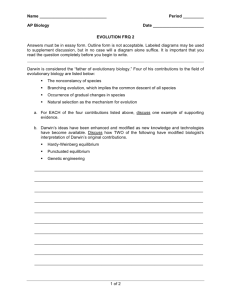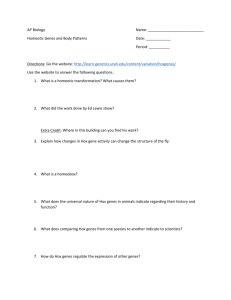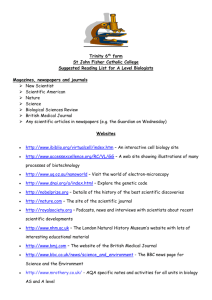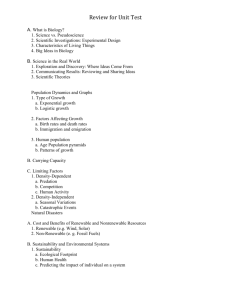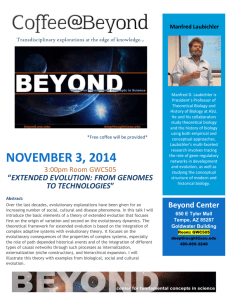Lesson Study Final Report (Short Form)
advertisement
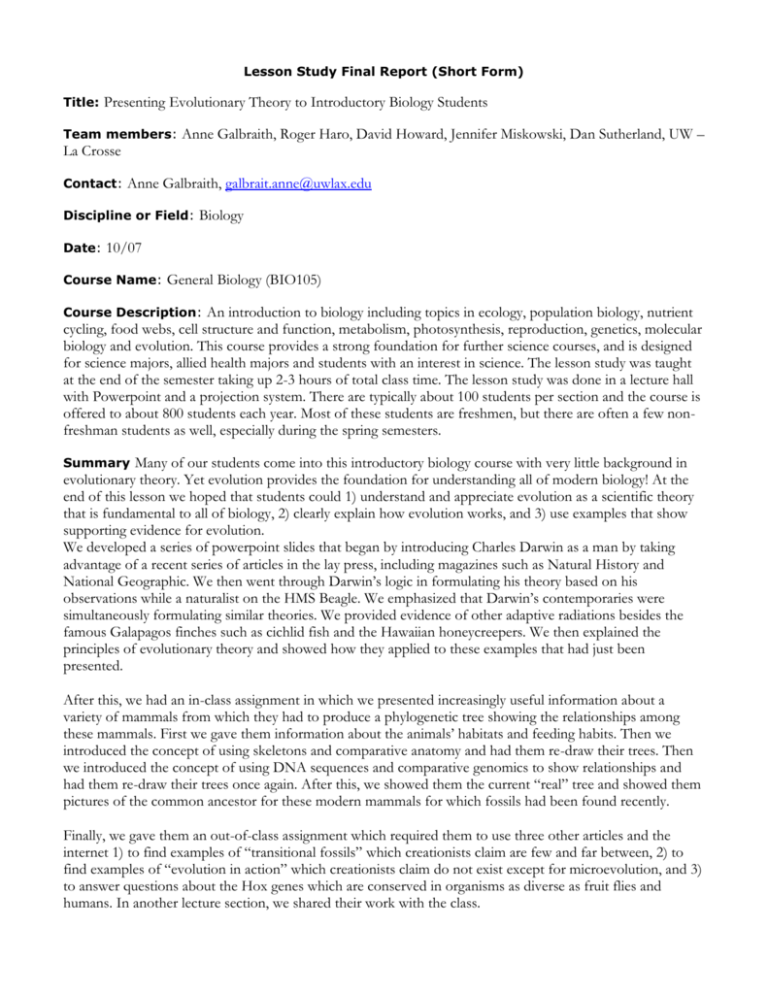
Lesson Study Final Report (Short Form) Title: Presenting Evolutionary Theory to Introductory Biology Students Team members: Anne Galbraith, Roger Haro, David Howard, Jennifer Miskowski, Dan Sutherland, UW – La Crosse Contact: Anne Galbraith, galbrait.anne@uwlax.edu Discipline or Field: Date: Biology 10/07 Course Name: General Biology (BIO105) An introduction to biology including topics in ecology, population biology, nutrient cycling, food webs, cell structure and function, metabolism, photosynthesis, reproduction, genetics, molecular biology and evolution. This course provides a strong foundation for further science courses, and is designed for science majors, allied health majors and students with an interest in science. The lesson study was taught at the end of the semester taking up 2-3 hours of total class time. The lesson study was done in a lecture hall with Powerpoint and a projection system. There are typically about 100 students per section and the course is offered to about 800 students each year. Most of these students are freshmen, but there are often a few nonfreshman students as well, especially during the spring semesters. Course Description: Many of our students come into this introductory biology course with very little background in evolutionary theory. Yet evolution provides the foundation for understanding all of modern biology! At the end of this lesson we hoped that students could 1) understand and appreciate evolution as a scientific theory that is fundamental to all of biology, 2) clearly explain how evolution works, and 3) use examples that show supporting evidence for evolution. We developed a series of powerpoint slides that began by introducing Charles Darwin as a man by taking advantage of a recent series of articles in the lay press, including magazines such as Natural History and National Geographic. We then went through Darwin’s logic in formulating his theory based on his observations while a naturalist on the HMS Beagle. We emphasized that Darwin’s contemporaries were simultaneously formulating similar theories. We provided evidence of other adaptive radiations besides the famous Galapagos finches such as cichlid fish and the Hawaiian honeycreepers. We then explained the principles of evolutionary theory and showed how they applied to these examples that had just been presented. Summary After this, we had an in-class assignment in which we presented increasingly useful information about a variety of mammals from which they had to produce a phylogenetic tree showing the relationships among these mammals. First we gave them information about the animals’ habitats and feeding habits. Then we introduced the concept of using skeletons and comparative anatomy and had them re-draw their trees. Then we introduced the concept of using DNA sequences and comparative genomics to show relationships and had them re-draw their trees once again. After this, we showed them the current “real” tree and showed them pictures of the common ancestor for these modern mammals for which fossils had been found recently. Finally, we gave them an out-of-class assignment which required them to use three other articles and the internet 1) to find examples of “transitional fossils” which creationists claim are few and far between, 2) to find examples of “evolution in action” which creationists claim do not exist except for microevolution, and 3) to answer questions about the Hox genes which are conserved in organisms as diverse as fruit flies and humans. In another lecture section, we shared their work with the class. We hoped that the human approach to presenting Charles Darwin would alleviate the preconceived ideas by some of our students that he was an “evil atheist”. We hoped that by presenting them with a myriad of examples that are not “worn out”, and by forcing them to find even more examples on their own with an assignment out-of-class, that they would understand the theory better and find it more difficult to just toss this theory aside. We still need to come up with a good assessment tool. See appendices . 1. Table and data used for in-class assignment 2. Instructions for out-of-class assignment 3. 1. PDF file of PowerPoint slides linked separately Diet Habitat Black Bear Harp Seal Hippopotamus Sea Otter Penguin Harbor Porpoise Blue Whale Portion of cytochrome b DNA sequence ACAGC Sea Otter ACAGC Harp Seal ACCGC Harbor Porpoise ACCGC Blue Whale ACCGC Hippopotamus ACAGC Black Bear CTGGC Penguin Other Observations Skeleton pelvis Skeleton limbs BIO105 Final Out-of-Class Assignment (15 pts.) Introduction In 1859 when Charles Darwin published his evolutionary theory in a book entitled “On the Origin of Species by Means of Natural Selection,” he proposed a mechanism for how organisms have come to be adapted to environments ranging from arctic tundra to tropical rainforest. Chapter 23 in Freeman provides the basic information that you will need to complete the following outside-of-class homework assignment. In addition, the November 2005 Natural History Magazine issue was completely devoted to articles on Charles Darwin and recent advances in the field of evolutionary biology. We have selected three articles from recent Natural History Magazine issues and placed them on your D2L site to serve as background reading to help with the homework assignment. The three articles are entitled: “Evolution in Action,” “The Fossils Say Yes,” and “The Birth of the Uterus.” These articles are written for a general biology audience which is you. Traditionally, opponents of evolution have pointed to several supposed flaws in the explanatory power of evolution by natural selection. Detractors point to numerous “gaps in the fossil record” and contend that evolution has never been observed to actually occur. Both of these shortcomings have been the target of intense research during the past several decades, and there are now numerous examples of transitional fossils that fill in those gaps, as well as convincing evidence for evolution occurring during timescales (decades or shorter) that are observable during a human lifetime. In lecture we examine the evolution of whales as an example of transitional fossils and the work of Peter and Rosemary Grant that definitively shows that beak sizes of Galapagos ground finches change measurably with environmental conditions. In addition to the classical and traditional study of evolutionary processes conducted by paleontologists and field biologists, the burgeoning field of molecular evolutionary biology and developmental biology (affectionately known as “EvoDevo”) has begun to shed considerable light on how genes regulate the expression and development of phenotypes and their evolutionary significance. In this out-of-class homework assignment, each group will examine a set of recent advances in evolutionary science that will hopefully add to your understanding of Darwin’s theory of “descent with modification.” Assignment Your instructor will assign one species from each of the two categories below for your group to research using the Internet. (You might want to use a search engine such as Google Scholar or Google Image Search.) 1. 2. 3. 4. I. Transitional Fossil Paleocastor nebrascensis Pezosiren portelli Acanthostega gunnari Sinornithosaurus millennia 1. 2. 3. 4. II. Evolution In Action Vestiaria coccinea Anolis sagrei Jadera haematoloma Littorina obtusata In addition, each group will answer questions regarding the genes responsible for the development of the mammalian uterus (see below). Instructions: Each group of no more than four people (put all the names on one of the slides or on an additional slide) will construct a three slide PowerPoint presentation that will be posted to the Drop Box on the D2L site. The deadline for this is Monday, December 12th by 5pm. The first slide should address the newly described transitional fossil (“missing link”) that your group is assigned from category I. You should find and include a picture of the fossil and/or a reconstruction of what the animal is supposed to look like. Also, describe the specific morphological features that your transitional species has in common with the two species between which it transitions. The second slide should succinctly (i.e., short but thoroughly) describe the changes that have occurred to your assigned extant (currently living) species from category II as a result of exposure to a changing environment. Again pictures of the species can be found on the Internet and pasted into your slide. The third slide will contain answers to the following questions about the evolution of the mammalian uterus: 1. The authors of the “Birth of the Uterus” refer to Homeotic (Hox) genes as master developmental control genes. What is the primary function of these Hox genes and how widespread are they in life forms on this planet? 2. Pages 38 and 39 of the same article show how the HoxA-9, HoxA-10, HoxA-11 and HoxA-13 genes each play a role in development of various parts of the female reproductive system of various vertebrate animals. Explain how the same genes might be responsible for such divergently different reproductive systems. 3. How might some of these Hox genes play a role in reproductive system cancers and disease of the human female? 4. The paper states that multiple Hox proteins play a role in uterus development in placental mammals. Furthermore, the different Hox genes are each expressed in different regions of the uterus. For example, HoxA-9 is expressed in the Fallopian tubes, while HoxA-10 is expressed in the upper uterus. What does it mean at the level of molecular biology to say that the HoxA-9 gene is only expressed in the Fallopian tube cells of the uterus? A. The HoxA-9 gene is on a chromosome in Fallopian tube cells, but that gene is not found in other uterus cells. B. The HoxA-9 gene is replicated in Fallopian tube cells, but not other uterus cells. C. The HoxA-9 gene is transcribed and translated in the Fallopian tube cells, but not other uterus cells. D. The HoxA-9 protein is activated in the Fallopian tube cells, but not other uterus cells. E. None of the above. 5. Hox genes have been around for >600 million years and are found in all animals, as well as some plants and fungi. Hox genes in different species have similar, but not identical sequences. That means that over time, changes in the DNA of the Hox genes (aka mutations) have occurred. The paper specifically discussed changes that occurred in a subset of Hox genes that allowed the uterus to evolve. Based on this information, as well as our discussions in lecture, which of the following statements are true? A. Mutations to a DNA sequence are always deleterious (bad) to an organism. B. Mutations to a DNA sequence can sometimes be beneficial to an organism. C. A few changes in a DNA sequence can allow the resulting protein to have a slightly new or different function. D. Most of the DNA sequence of a gene needs to be changed to cause the resulting protein to have a slightly new or different function. E. A & D F. B & C

